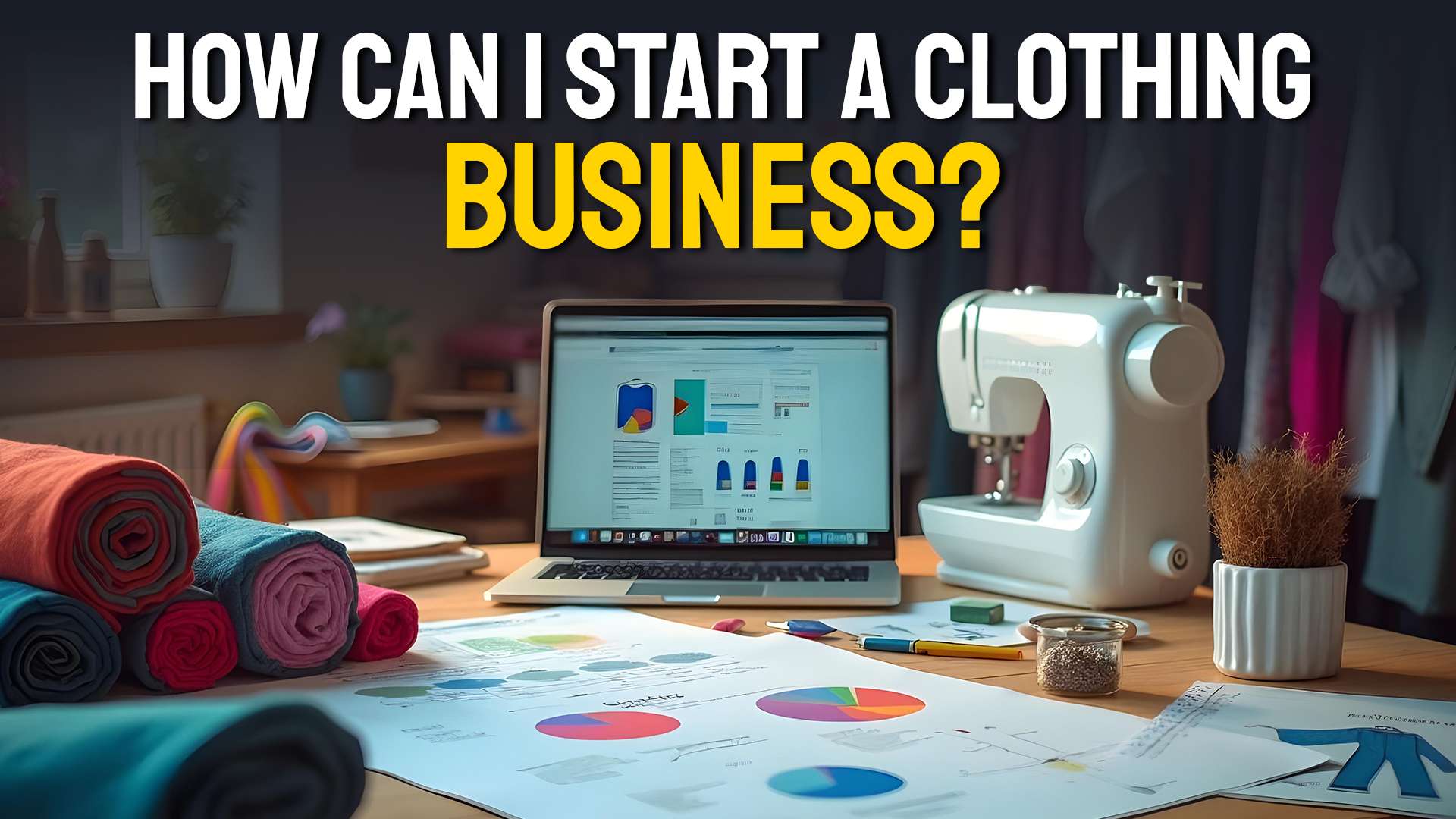how can I start a clothing business

Share Blog:
Starting a clothing business can be an exciting and profitable venture if planned and executed well. Here’s a step-by-step guide to help you get started:
1. Identify Your Niche
Choose a specific focus for your clothing business. Your niche could be based on:
-
Target audience: Kids, women, men, or unisex clothing.
-
Style: Casual, formal, ethnic, at leisure, sustainable fashion, etc.
-
Category: Dresses, t-shirts, active wear, or seasonal wear.
-
Tip: Research market trends and analyze competitors to find gaps in the market.
2. Create a Business Plan
A solid plan will guide your business. Include:
-
Business name and branding ideas.
-
Mission and vision of your brand.
-
Target market: Who are your customers?
-
Product strategy: What clothing will you offer?
-
Marketing strategy: How will you attract customers?
-
Budget and financial plan: Initial investment, expected expenses, and revenue.

3. Choose a Business Model
Decide how you’ll operate:
-
Manufacture your own designs: Requires sourcing raw materials, hiring tailors/designers, and setting up production.
-
Buy wholesale and resell: Partner with wholesalers or manufacturers for ready-made clothing.
-
Drop shipping: Partner with suppliers who handle inventory and shipping.
-
Franchise: Partner with an established brand (like Zara, Biba, etc.).
4. Register Your Business
Ensure your business is legally compliant:
-
Business structure: Sole proprietorship, partnership, or private limited company.
-
Obtain necessary licenses and permits (GST registration in India, trade license, etc.).
5. Build Your Brand
-
Logo and tagline: Design a memorable logo and tagline.
-
Packaging: Invest in attractive packaging.
-
Online presence: Create a professional website and social media accounts.
-
Unique Selling Point (USP): What sets your brand apart?
6. Source Materials and Suppliers
-
If manufacturing, source high-quality fabrics and accessories.
-
If reselling, identify reliable wholesale suppliers.
-
Build strong relationships with suppliers for better deals.
7. Set Up Your Operations
-
Location: Decide between an online store, a physical shop, or both.
-
Inventory management: Organize stock effectively.
-
Logistics: Arrange shipping, delivery, and storage (for physical products).
8. Price Your Products
Consider production costs, market rates, and your target audience’s willingness to pay. Ensure your pricing covers costs and leaves room for profit.
9. Market Your Business
-
Social media marketing: Use Instagram, Facebook, and Pinterest for promotions.
-
Influencer collaborations: Partner with influencers for better reach.
-
E-commerce platforms: List products on Amazon, Flipkart, or Myntra.
-
Offline marketing: Distribute flyers, and host launch events or pop-ups.
10. Launch and Scale
-
Start with a soft launch to get customer feedback.
-
Use analytics to track sales and customer behavior.
-
Expand by adding new collections or reaching new markets.
Key Steps to Starting a Clothing Business in India:
-
Define Your Niche: Identify your target audience, preferred styles, and product categories while aligning with market trends like Indo-Western fusion or sustainable fashion.
-
Develop a Business Plan: Establish your brand identity, analyze your target market, create a budget, decide on sales channels, and set clear revenue objectives.
-
Select a Business Model: Choose from manufacturing, wholesale resale, dropshipping, or franchising, based on your goals and resources.
-
Register Your Business: Ensure legal compliance by obtaining GST registration, trade licenses, and protecting your brand with trademark registration.
-
Build Your Brand: Craft a memorable logo, create a tagline, use sustainable packaging, and highlight a unique selling point (USP) to stand out.
-
Source Materials and Suppliers: Collaborate with reliable suppliers or textile hubs to ensure consistent quality and cost-effective sourcing.
-
Set Up Operations: Decide between opening a physical store, building an online presence, or both, and partner with delivery services to streamline logistics.
-
Determine Pricing: Account for production, shipping, and marketing costs while staying competitive. Use seasonal discounts or combo deals to attract customers.
-
Promote Your Business: Leverage social media platforms, collaborate with influencers, and participate in exhibitions or trade fairs to boost visibility.
-
Launch and Grow: Start with a soft launch to test the market, gather customer feedback, and expand gradually with new products or target regions.
Steps to Start a Clothing Business with Ajmera Fashion
1. Learn About Ajmera Fashion’s Products
-
Review their extensive range of clothing, including sarees, kurtis, lehengas, dress materials, men’s wear, and kids’ wear.
-
Understand their pricing structure and bulk order policies.
-
Align your product selection with your chosen niche, such as bridal wear, daily ethnic wear, or festive collections.
2. Visit Their Surat Outlet or Connect Online
-
Explore their Surat hub to personally assess the quality and variety of products.
-
Alternatively, contact their team through their website or phone to place orders or obtain digital catalogs.
-
Start small with their beginner-friendly “low-investment packages” ideal for new entrepreneurs.
3. Select a Suitable Business Model
-
Wholesale Resale: Purchase bulk stock and resell it in markets, stores, or exhibitions.
-
Online Selling: Launch an e-commerce site or sell via platforms like Flipkart, Amazon, and social media.
-
Home-Based Selling: Begin locally by selling to family, friends, or small community groups, then scale up gradually.
4. Identify Your Target Audience
-
Define your target customer base: women, men, or children.
-
Focus on specific occasions such as festive wear, wedding collections, or everyday attire.
-
Choose whether to cater to urban, semi-urban, or rural markets, depending on demand patterns.
5. Complete Legal Requirements
-
Register your business as a sole proprietorship, partnership, or private limited company.
-
Obtain a GST number if your annual turnover exceeds ₹20 lakhs.
-
Keep proper records and invoices to comply with tax regulations.
6. Plan Inventory and Storage
-
Start with a smaller inventory to test demand and minimize upfront costs.
-
Maintain a catalog of your product offerings to streamline customer interactions.
-
Store products in clean, organized spaces to retain their quality and appeal.
7. Establish Sales Channels
-
Physical Store: Open your shop in areas with high foot traffic or near residential zones.
-
Online Presence: Create your own website or use social platforms like Instagram and Facebook to showcase products.
-
E-Commerce Marketplaces: List your products on marketplaces such as Myntra, Amazon, or Flipkart for increased reach.

For Franchisee Inquiry, Call: +9163521 77288
8. Market Your Brand
-
Use engaging social media campaigns to highlight trending designs and collections from Ajmera Fashion.
-
Organize festive sales or discount campaigns during high-demand seasons like Diwali and wedding months.
-
Collaborate with local influencers or bloggers to increase your brand’s visibility and credibility.
9. Streamline Logistics
-
Take advantage of Ajmera Fashion’s shipping services, ensuring smooth delivery to your business location.
-
For customer orders, partner with reliable courier services such as Ecom Express, Delhivery, or India Post to ensure timely distribution.
10. Grow Your Business
-
Diversify by introducing new categories, such as Western wear, accessories, or fusion clothing.
-
Foster long-term relationships with Ajmera Fashion for exclusive product ranges and better pricing deals.
Why Ajmera Fashion is Ideal for Your Business
-
Low Initial Investment: Perfect for startups or businesses with limited capital.
-
Vast Product Range: Offers a variety of styles and categories to suit diverse customer preferences.
-
Convenient Access: Provides online ordering, doorstep delivery, and detailed catalogs.
-
Entrepreneurial Support: Offers guidance and training sessions tailored for new business owners.
The methods you've outlined are great ways to contact Ajmera Fashion for starting a clothing business. Here’s a recap of the contact options:
-
Physical Store Visit in Surat: G-1,Ground Floor, Surana 101, Sahara Darwaja Ring Rd, Umarwada, Surat, Gujarat 395002
-
Online Contact:
-
Website: Ajmera Fashion
-
Phone: 6358907210
-
Email: [email protected]
-
-
Social Media: Reach out via platforms like Facebook (Ajmera Fashion Facebook) and Instagram (ajmerafashion) for product details and quick responses.
-
Youtube Channel: Ajmera Fashion - Synthetic Saree Manufacturer
-
Wholesale Platforms: Search for Ajmera Fashion on platforms like IndiaMART or TradeIndia to contact them easily.
-
Request a Catalog: You can request a catalog to explore product options and choose items for bulk orders.
-
Phone/WhatsApp: Get in touch directly through phone or WhatsApp for a more personalized experience.

For Wholsale Inquiry, Call: +916358907210
Also read: Why is Clothing Franchise Business Popular In India.
FAQs on Starting a Clothing Business
What is the first step to starting a clothing business?
Identify your niche by choosing a specific audience, style, or category based on market trends and demand.
Do I need to register my clothing business?
Yes, registering your business ensures legal compliance. You may need GST registration, a trade license, and possibly a trademark for your brand.
Should I manufacture my own designs or buy wholesale?
-
Buy wholesale for faster setup and established designs.
What are the popular business models in the clothing industry?
-
Wholesale resale
-
Drop shipping
-
Manufacturing your designs
-
Franchise with established brands
How can I source products for my clothing business?
Partner with reliable suppliers like Ajmera Fashion in Surat or explore local textile hubs.
What are the best platforms to market a clothing business?
Social media (Instagram, Facebook, Pinterest), e-commerce marketplaces (Amazon, Myntra), and offline methods like flyers and pop-ups are highly effective.
What makes Ajmera Fashion a good partner for startups?
Ajmera Fashion offers:
-
Low initial investment options.
-
A vast product range including sarees, kurtis, and kids' wear.
-
Entrepreneurial support with catalogs, guidance, and doorstep delivery.
What is a USP (Unique Selling Point) in the clothing business?
Your USP sets you apart. Examples include sustainable fashion or budget-friendly ethnic wear.
Can I start a clothing business from home?
Yes, with options like home-based selling, online stores, and dropshipping, you can start with minimal investment.

For Franchisee Enquiry, Call: +9163521 77288
Also Read...





